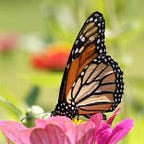Vivian Negrón-Ortiz: Rare Plant Conservation
Vivian Negrón Ortiz was born and raised in Cabo Rojo, Puerto Rico. She completed her undergraduate and Master’s in Biology from the University of Puerto Rico, Mayagüez, with a concentration in Plant Ecology. For her Master’s thesis, she studied a native cycad, Zamia erosa, its life-history stages, including seed germination and recruitment, over three years in the Cambalache State Forest, Puerto Rico. Zamia erosa is one of the three native cycads now recognized in the island.
She earned a Ph.D. in Botany from Miami University, Oxford, Ohio, where she is currently an Affiliate Faculty Member. Her dissertation focused on the systematics and breeding systems of Ernodea, a genus of flowering shrubs in the coffee family, Rubiaceae, which is endemic to the Caribbean Basin and the Florida Keys.
After finishing her doctoral degree, Vivian spent two years at Fairchild Tropical Garden, Florida, as a Cycad Biologist, where she continued her work with the genus Zamia. There, she investigated the effects of prescribed wet‐season fire on the demography of Zamia pumila in slash pine savanna of Everglades National Park, Florida. It was at Fairchild that her interest and work on conservation was initiated, by investigating the reproductive biology and low fruit set of Consolea corallicola, a rare cactus native to the Florida Keys that is now listed as federally endangered. “To effectively understand the cause of seed set failure, this research led her to collaborate with other scientists in embryology studies involving all Consolea species in the Caribbean Basin.”
Since 2007, Vivian has been a Botanist with the U.S. Fish and Wildlife Service (Service) at the Panama City Field Office, Florida. She focuses on protection and preservation of 10 federally listed and several at-risk plant species and their habitats of northwest Florida and parts of Alabama and Georgia. Some of her responsibilities in this position include coordinating, implementing, and facilitating activities pursuant to Sections 4, 6, 7, 8, and 10 of the Endangered Species Act (ESA); implementing research and surveys related to conservation strategies and management, and identifying conservation opportunities to prioritize resources to advance the recovery of rare, imperiled plant species.
Other parts of Vivian’s current job involve providing ‘consultation’ for other federal agencies that are reviewing development proposals that might impact listed species. She also prepares ‘Biological Opinions,’ that usually include conservation recommendations to further the recovery of listed species, and it also may include reasonable and prudent measures, as needed, to minimize any “take” of listed species. In the course of her work she also interacts with state agencies, private landowners, consultants, schools, and the public. To help meet the ultimate goal of the ESA, she not only seeks out researchers to investigate crucial gaps in knowledge, but also evaluates proposals, administers grants, and in some cases collaborates in research projects or conducts her own research.
“Conducting research to understand the biology needed to inform sound conservation strategies for rare plant species is Vivian’s favorite aspect of her job,” Vivian shares.
Her research work has included systematics, breeding systems, ecology, and applications of these to conservation. Her first collaboration as a USFWS Botanist, she collaborated with Plant Biologists from the University of Georgia to study genetic variation within and among populations of federally threatened Euphorbia telephioides (telephus spurge). She continued this research with other collaborators, investigating the timing and patterns of growth and reproduction, in situ seed germination and seedling establishment, as well as demographic models. This has enabled Vivian to design a conservation plan that recommended key plant populations for protection and proposed changes to overall management.
A second example is her studies to determine change in abundance over a period of 20 years and to understand the lack of seedling recruitment of the federally threatened Ribes echinellum (Miccosukee gooseberry). This research demonstrates the importance of long-term monitoring to understand population growth and persistence, to prevent extinction and also guide management.
Vivian considers it “critical to educate the next generation of plant conservationists.” She co-advises graduate students and participates with the Service’s various programs that support this effort. Her current students are studying the genetics and clonality of threatened Scutellaria floridana and petitioned for listing of Hymenocallis henryae — two rare plants endemic to the Florida Panhandle.
Vivian’s whole career has shown her commitment to the conservation of federally protected plant resources of the Southeast U.S. and the nation as a whole. Her efforts have led to several major initiatives and recognitions. In 2008, she helped coordinate the first southeastern Plant Recovery Meeting of the Service. Vivian played a lead role in drafting a nationwide conservation initiative to improve plant conservation under ESA. She was recognized with the Regional Director’s Distinguished Biologist of the Year Award in 2013. Vivian is currently co-leading the development of the Florida Rare Plant Conservation Endowment, an effort that promotes funding to help preserve, conserve, and restore the native plants and habitats of Florida.
To learn more about Vivian Negron Ortiz’s work in botany and conservation, check out her numerous publications, discoverable via USFWS Library. #FWSscholar is brought to you by the USFWS Library, #WeAreUSFWS.
